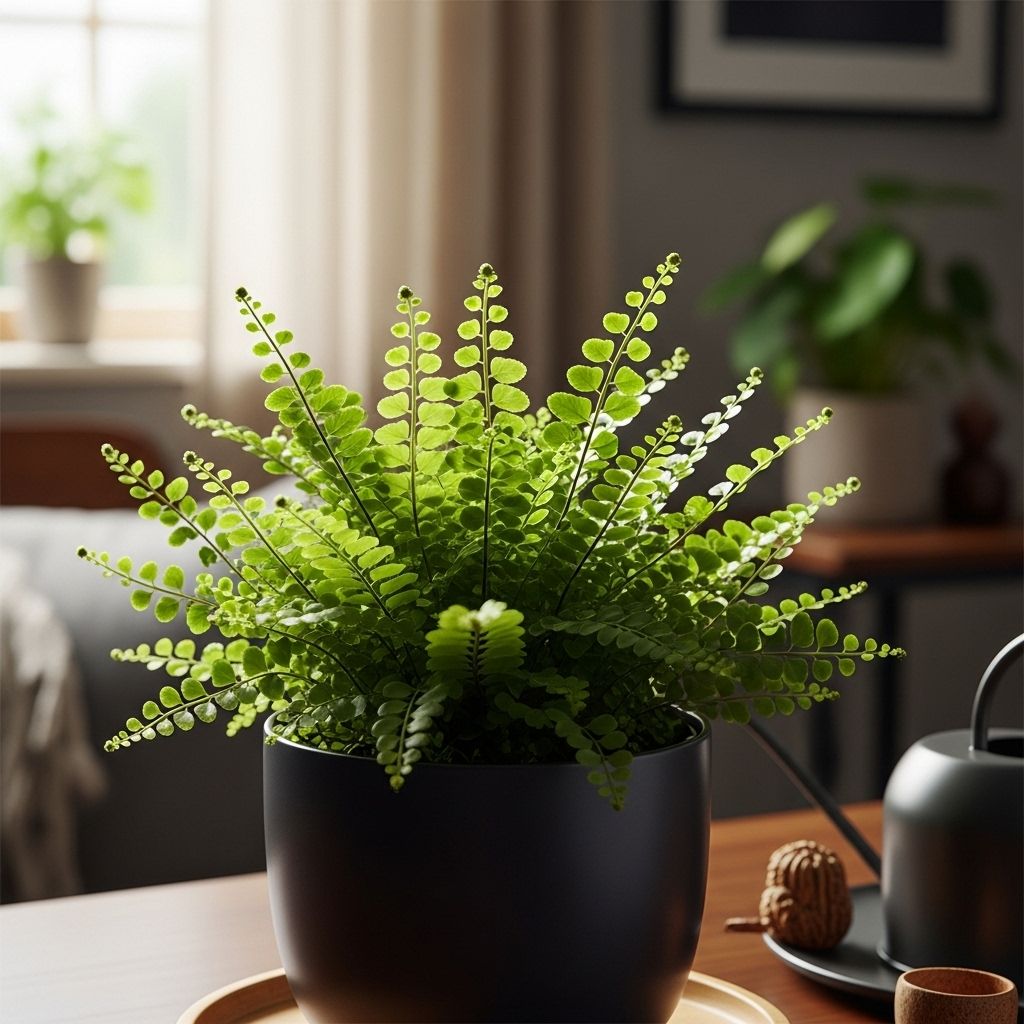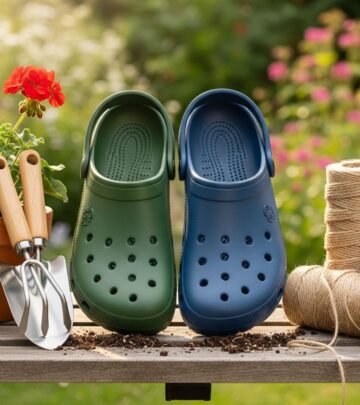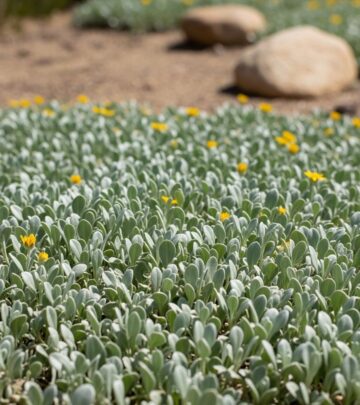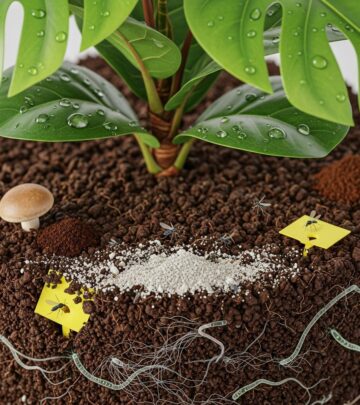Button Fern Care Guide: Essential Tips For Lush Indoor Growth
Discover the delicate beauty and simple care requirements of the charming Button Fern houseplant

Image: HearthJunction Design Team
Gardening 101: Button Fern (Pellaea rotundifolia)
The Button Fern, scientifically known as Pellaea rotundifolia, is one of the most charming and manageable fern varieties available for indoor cultivation. Native to the woodlands and limestone cliffs of New Zealand and Australia, this delightful plant earns its common name from the distinctive round, button-like leaflets that adorn its slender, wiry stems. Unlike some of its more demanding fern relatives, the Button Fern offers both visual appeal and relatively straightforward care requirements, making it an excellent choice for gardeners of all experience levels.
With its compact growth habit and elegant arching fronds, the Button Fern brings a touch of woodland serenity to any indoor space. Growing to a modest height of typically 12-18 inches, this fern is perfectly suited for tabletops, shelves, and hanging baskets where its cascading form can be fully appreciated. The dark green, circular leaflets provide wonderful textural contrast to plants with broader foliage, creating visual interest in mixed plant displays.
Button Fern at a Glance
| Characteristic | Details |
|---|---|
| Botanical Name | Pellaea rotundifolia |
| Common Name | Button Fern, New Zealand Button Fern |
| Native Region | New Zealand and Australia |
| Plant Type | Evergreen perennial fern |
| Mature Size | 12-18 inches tall, 1-2 feet spread |
| Growth Rate | Moderate |
| Light Requirements | Medium to bright indirect light |
| Soil Preference | Light, well-draining potting mix |
| Toxicity | Non-toxic to pets and humans |
The Perfect Environment for Your Button Fern
Creating the ideal growing conditions for your Button Fern is key to ensuring its long-term health and vibrant appearance. While this fern is more forgiving than many of its cousins, understanding its preferences will help you provide optimal care.
Light Requirements
Button Ferns thrive in medium to bright indirect light conditions. Unlike many other fern varieties that demand deep shade, Button Ferns can tolerate and even enjoy brighter situations as long as they’re protected from direct sunlight. A sun-filled kitchen or living room with filtered light is an excellent location, as is a spot near a north-facing window. While these hardy ferns can adapt to lower light environments, they perform best with consistent, indirect brightness.
If you notice your Button Fern’s fronds becoming pale or the plant appearing leggy with long spaces between leaflets, it’s likely receiving insufficient light. Conversely, crisp, brown edges on the leaflets often indicate too much direct sun exposure. Finding the sweet spot of bright but indirect light will reward you with lush, vibrant growth.
Temperature and Humidity
One of the Button Fern’s most appealing characteristics is its adaptability to normal household conditions. While it appreciates higher humidity, it doesn’t demand the greenhouse-like environment that many other ferns require. The ideal temperature range falls between 60-75°F (16-24°C), which aligns perfectly with comfortable home temperatures.
Although Button Ferns can tolerate average household humidity levels, they will look their absolute best with slightly elevated moisture in the air. Consider placing your fern in naturally humid areas of your home such as bathrooms or kitchens. Alternatively, position your plant on a pebble tray with water or near other plants to create a more hospitable microclimate. Avoid placing your Button Fern near heating vents, radiators, or in drafty areas where temperature fluctuations and dry air can stress the plant.
Essential Care Guidelines
Watering Wisdom
Button Ferns appreciate consistent moisture but are surprisingly more tolerant of occasional drying than many of their fern relatives. The key is finding the balance between keeping the soil pleasantly moist and avoiding waterlogged conditions that can lead to root rot.
Water your Button Fern when the top inch of the soil begins to feel dry to the touch. This typically translates to watering once or twice a week during the growing season (spring and summer) and less frequently during the dormant winter months. Always ensure that your plant pot has adequate drainage holes, and never allow the fern to sit in standing water.
A good watering technique involves thoroughly saturating the soil until water flows from the drainage holes, then allowing the excess to drain completely. If your home has particularly dry air, misting the fronds occasionally can provide supplemental humidity, though this shouldn’t replace proper watering practices.
Soil and Potting
The ideal growing medium for Button Ferns is light and well-draining while still retaining sufficient moisture. A standard houseplant potting mix typically works well, especially when enhanced with additional perlite or vermiculite to improve drainage. You can create your own optimal mix by combining equal parts of peat moss (or coconut coir for a more sustainable option), perlite, and a high-quality potting soil.
When it comes to containers, Button Ferns aren’t particularly fussy, though pots with good drainage are essential. Terra cotta pots can be excellent choices as they allow soil to breathe and reduce the risk of overwatering, while decorative glazed ceramic containers make attractive homes as long as they have drainage holes. For hanging displays, lightweight plastic nursery pots inserted into decorative hangers provide both functionality and aesthetic appeal.
Feeding and Fertilization
Button Ferns benefit from light, regular feeding during their active growing season. Apply a balanced, water-soluble houseplant fertilizer diluted to half the recommended strength once a month from spring through early fall. Alternatively, a slow-release fertilizer applied at the beginning of the growing season can provide steady nutrition with minimal effort.
During the winter months when growth naturally slows, withhold fertilizer entirely to prevent salt buildup in the soil. If you notice brown tips developing on your fern despite proper watering, this could indicate fertilizer burn from over-application. In this case, flush the soil thoroughly with clean water and reduce the frequency or concentration of future feedings.
Maintenance and Grooming
Button Ferns require minimal grooming to maintain their attractive appearance. Occasionally, you may need to remove any brown or yellowing fronds by trimming them at the base with clean, sharp scissors. This not only keeps your plant looking its best but also encourages fresh growth and prevents potential disease issues.
Unlike many houseplants, Button Ferns don’t require regular pruning for shape or size control. Their naturally compact growth habit means they rarely outgrow their allotted space, and their distinctive form is best preserved by allowing the plant to express its natural architecture.
Every two to three years, your Button Fern will benefit from repotting to refresh its soil and provide room for new growth. The best time for this activity is in early spring as the plant enters its active growing phase. Choose a container just one size larger than the current pot, as these ferns prefer to be somewhat root-bound and may struggle in overly spacious containers.
Propagation Methods
The most reliable method for propagating Button Ferns is through division of established plants. This is ideally performed during repotting in the spring when the plant is naturally geared toward new growth. To divide your Button Fern:
- Carefully remove the plant from its pot and gently brush away excess soil to expose the root system.
- Look for natural divisions where the rhizomes (underground stems) have created separate growth points.
- Using clean, sharp scissors or a knife, cut through the rhizomes to create smaller plants, ensuring each division has both roots and several healthy fronds.
- Plant each division in an appropriately sized pot with fresh potting mix, water thoroughly, and place in a location with bright, indirect light.
- Keep the soil consistently moist for several weeks while the new plants establish their root systems.
While Button Ferns do produce spores (the fern equivalent of seeds), propagation through spores is challenging and time-consuming for home gardeners. Division offers a much more straightforward and rewarding approach to increasing your fern collection.
Troubleshooting Common Issues
Even with proper care, Button Ferns occasionally face challenges. Being able to identify and address common problems quickly will help keep your plant thriving:
Browning Frond Tips
This common issue typically indicates either low humidity, excessive fertilization, or mineral buildup from tap water. Increase humidity around your plant, reduce fertilizer applications, and consider using filtered or distilled water if your tap water is heavily chlorinated or contains high mineral content.
Yellowing Fronds
Widespread yellowing often signals overwatering or poor drainage. Check that your pot has adequate drainage holes and adjust your watering schedule accordingly. Allow the top inch of soil to dry between waterings and never let your fern sit in standing water.
Pest Problems
Button Ferns are relatively resistant to pests, but they can occasionally attract spider mites, especially in dry conditions. These tiny invaders create fine webbing between fronds and cause stippling on the leaflets. Regular misting and maintaining adequate humidity are the best preventative measures. If an infestation occurs, treat with insecticidal soap or neem oil, being sure to cover all plant surfaces including the undersides of fronds.
Frequently Asked Questions
Q: Are Button Ferns safe for pets?
A: Yes, Button Ferns (Pellaea rotundifolia) are non-toxic to both cats and dogs, making them excellent choices for pet owners who want to incorporate greenery into their homes without safety concerns.
Q: How fast do Button Ferns grow?
A: Button Ferns have a moderate growth rate. Under optimal conditions, they can produce new fronds regularly during the growing season, but they aren’t known for aggressive or rapid expansion. Expect your Button Fern to take 2-3 years to reach its full mature size.
Q: Can Button Ferns be grown outdoors?
A: Button Ferns can be grown outdoors in USDA hardiness zones 9-11 where winters are mild. They make excellent additions to shaded garden spots with well-draining soil. In colder climates, they can be moved outdoors for the summer months but should be brought inside before temperatures drop below 50°F (10°C).
Q: Why are my Button Fern’s fronds curling?
A: Curling fronds typically indicate either underwatering or exposure to excessively dry air. Increase your watering frequency slightly and consider adding supplemental humidity through misting, a pebble tray, or a small humidifier nearby.
Q: Do Button Ferns need special winter care?
A: During winter, Button Ferns enter a semi-dormant state and require adjusted care. Reduce watering frequency (while still maintaining slightly moist soil), eliminate fertilization, and ensure they’re positioned away from cold drafts and heating vents. Normal care can resume when new growth appears in spring.
With its forgiving nature, distinctive appearance, and modest care requirements, the Button Fern deserves consideration for any indoor plant collection. Whether displayed as a standalone specimen or incorporated into a larger arrangement of houseplants, this charming fern brings a touch of woodland elegance to interior spaces while demanding relatively little in return. By understanding and catering to its basic needs for indirect light, consistent moisture, and protection from environmental extremes, you’ll be rewarded with a beautiful, long-lived companion plant that enhances your home with its natural grace.
References
- https://www.thespruce.com/button-fern-care-guide-8387289
- https://www.gardenista.com/posts/gardening-101-button-fern/
- https://www.youtube.com/watch?v=98EHL8ODHv0
- https://www.gardeningknowhow.com/houseplants/ferns-houseplants/button-fern-indoors.htm
- https://mahindranursery.com/blogs/plant-guide/button-fern-plant-a-complete-guide-to-care-propagation-and-common-issues
Read full bio of medha deb












